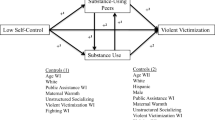Abstract
The general theory of crime posits that variability in propensities to engage in crime and deviance is partly a function of individual differences in low self-control (LSC). LSC is hypothesized to comprise of six subdomains: impulsiveness, preference for physical activities, risk seeking, self-centeredness, preference for simple tasks, and volatile temper. Using structural equation modeling, LSC was examined to determine if a global self-control measure or a multidimensional measure of its subdomains was a more salient predictor of violent and property crimes and drug use among adolescent male offenders (n = 317). Only the multidimensional model adequately fit the data. Risk seeking predicted violent and property crimes, whereas volatile temper predicted violent crimes and drug use. The general theory of crime may obscure differences in the explanatory power of self-control subfactors for specific types of crime, especially within at-risk youth. Findings have implications for effective interventions among adolescent males with criminal histories.

Similar content being viewed by others
References
Gottfredson MR, Hirschi T. A General Theory of Crime. Stanford, CA: Stanford University Press; 1990.
Grasmick HG, Title CR, Bursik RJ, et al. Testing the core empirical implications of Gottfredson and Hirschi’s general theory of crime. Journal of Research in Crime and Delinquency. 1993;30:30–46.
Arneklev BJ, Grasmick HG, Tittle CR, et al. Low self-control and imprudent behavior. Journal of Quantitative Criminology. 1993;9:225–247.
Evans TD, Cullen FT, Burton Jr VS, et al. The social consequences of self-control: testing the general theory of crime. Criminology. 1997;35:475–501.
Longshore D. Self-control and criminal activity: a prospective test of the general theory of crime. Social Problems. 1998;45:102–113.
Longshore D, Turner S, Stein JA. Self-control in a criminal sample: an examination of construct validity. Criminology. 1996;34:209–228.
Piquero AR, Rosay AB. The reliability and validity of Grasmick et al.’s self-control scale: a comment on Longshore et al. Criminology. 1998;36:157–173.
Vazsonyi AT, Crosswhite JM. A test of Gottfredson and Hirschi’s general theory of crime in African American adolescents. Journal of Research in Crime and Delinquency. 2004;41:407–432.
Cauffman E, Steinberg L, Piquero AR. Psychological, neuropsychological and physiological correlates of serious antisocial behavior in adolescence: the role of self-control. Criminology. 2005;43:133–176.
Benda BB, Toombs NJ, Corwyn RF. Self-control, gender, and age: a survival analysis of recidivism among boot camp graduates in a 5-year follow-up. In: Benda BB, Pallone NJ, eds. Rehabilitation Issues, Problems, and Prospects in Boot Camp. New York: Haworth; 2005:115–132.
Tangney JP, Baumeister RF, Boone AL. High self-control predicts good adjustment, less pathology, better grades, and interpersonal success. Journal of Personality. 2004;72:271–322.
Marcus B. Self-control in the general theory of crime: Theoretical implications of a measurement problem. Theoretical Criminology. 2004;8:33–55.
Pratt TC, Cullen FT. The empirical status of Gottfredson and Hirschi’s general theory of crime: a meta-analysis. Criminology. 2000;38:931–964.
Marcus B. An empirical examination of the construct validity of two alternative self-control measures. Educational and Psychological Measurement. 2003;63:674–706.
Arneklev BJ, Grasmick HG, Bursik RJ. Evaluating the dimensionality and invariance of “low self-control”. Journal of Quantitative Criminology. 1999;15:307–331.
Longshore D, Stein JA, Turner S. Reliability and validity of a self-control measure: rejoinder. Criminology. 1998;36:175–182.
Vazsonyi AT, Pickering LE, Junger M, et al. An empirical test of a general theory of crime: a four-nation comparative study of self-control and the prediction of deviance. Journal of Research in Crime and Delinquency. 2001;38:91–131.
Piquero AR, Brame R, Moffitt TE. Extending the study of continuity and change: gender differences in the linkage between adolescent and adult offending. Journal of Quantitative Criminology. 2005;21:219–243.
Ribeaud D, Eisner M. The ‘drug-crime link’ from a self-control perspective. European Journal of Criminology. 2006;3:33–67.
Longshore D, Chang E, Hsieh S, et al. Self-control and social bonds: a combined control perspective on deviance. Crime & Delinquency. 2004;50:542–564.
Tibbetts SG, Whittimore JN. The interactive effects of low self-control and commitment to school on substance abuse among college students. Psychological Reports. 2002;90:327–337.
Anglin MD, Longshore D, Turner S. Treatment alternatives to street crime: an evaluation of five programs. Criminal Justice and Behavior. 1999;26:168–195.
Wood PB, Pfefferbaum B, Arneklev BJ. Risk-taking and self-control: social psychological correlates of delinquency. Journal of Crime and Justice. 1993;16:111–130.
Tittle CR, Ward DA, Grasmick HG. Gender, age, and crime/deviance: a challenge to self-control theory. Journal of Research in Crime and Delinquency. 2003;40:426–453.
Bentler PM. EQS 6 Structural Equations Program Manual. Encino, CA: Multivariate Software; 2006.
Satorra A, Bentler PM. A scaled difference chi-square test statistic for moment structure analysis. Psychometrika. 2001;66:507–514.
Bentler PM, Dudgeon P. Covariance structure analysis: statistical practice, theory, and directions. Annual Review of Psychology. 1996;47:563–592.
Yuan K-H, Chan W, Bentler PM. Robust transformation with applications to structural equation modeling. British Journal of Mathematical and Statistical Psychology. 2000;53:31–50.
Curran PJ, West SG, Finch JF. The robustness of test statistics to nonnormality and specification error in confirmatory factor analysis. Psychological Methods. 1996;1:16–29.
Hu L-T, Bentler PM. Cutoff criteria for fit indexes in covariance structural analysis: conventional criteria versus new alternatives. Structural Equation Modeling. 1999;6:1–55.
Chou C-P, Bentler PM. Model modification in covariance structure modeling: a comparison among likelihood ratio, Lagrange multiplier, and Wald tests. Multivariate Behavioral Research. 1990;25:115–136.
Benda BB. The robustness of self-control in relation to form of delinquency. Youth & Society. 2005;36:418–444.
Farrington DP. Editorial. Criminal Behavior and Mental Health. 1994;4:83–86.
Snyder HN. Juvenile arrests 2002. Office of juvenile justice and delinquency prevention juvenile justice bulletin 2004; September: 1–12.
Zuckerman M. Sensation Seeking and Risky Behavior. Washington, DC: American Psychological Association; 2007.
Author information
Authors and Affiliations
Corresponding author
Additional information
Support for this research was provided by Grants N01-DA-1-8408, R01-DA-12476, and P01-DA01070-34 from the National Institute on Drug Abuse. The authors would like to acknowledge the editorial support of M. Douglas Anglin.
Douglas Longshore died December 2005.
Rights and permissions
About this article
Cite this article
Conner, B.T., Stein, J.A. & Longshore, D. Examining Self-Control as a Multidimensional Predictor of Crime and Drug Use in Adolescents with Criminal Histories. J Behav Health Serv Res 36, 137–149 (2009). https://doi.org/10.1007/s11414-008-9121-7
Received:
Accepted:
Published:
Issue Date:
DOI: https://doi.org/10.1007/s11414-008-9121-7




